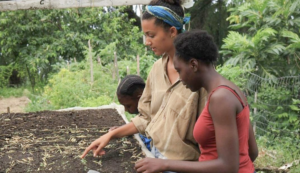
“Our farm will most likely be totally damaged; however, we still have all the knowledge and the experience. We didn’t leave all of it behind; we brought the knowledge with us”
Earth Day 2021 falls upon a dazed and different world. For the Caribbean nation of St. Vincent and the Grenadines, the 2021 celebration comes on the heels of the global pandemic –that almost every country is still dealing with– and a volcanic eruption. We are reminded of our fragile planet Earth.
The theme of Earth Day 2021 ‘Restore Our Earth’, focuses on natural processes, emerging green technologies and innovative thinking that can restore the world’s ecosystems. Focal areas include regenerative agriculture, climate restoration technologies, citizen science, reforestation efforts, cleanups, climate education and literacy. The 2021 theme links tightly with the UN Decade of Ecosystem Restoration, launching on World Environment Day on 5 June.
Many organisations have championed nature-based solutions and have been catalysts that motivate and mobilise – both students and local community members – to build resilience into their lives. From reforestation campaigns, to cleanups, to climate research; all these are being done in an effort to help restore nature and reverse the negative impacts of global change.
One such organisation is the Richmond Vale Academy (RVA). In celebration of Earth Day on 22 April, CPAG’s Communications Officer, Jay, sat down with the Director of the RVA, Ms. Stina Herberg, to talk about their regenerative farming strategies, and the way forward for the island nation.
Note to readers: On 9 April, 2021, the La Soufrière volcano located on the southern Caribbean island of St. Vincent had a full-blown eruption after months of effusive eruptions (spewing smoke, and rumbling). To date, 20,000 people have been evacuated.
This interview has been edited for brevity and readability.
———–
Jay: Can you share a bit about who Stina Herberg is and about your background?
Stina: My name is Stina and I am the Director of the Richmond Vale Academy, which is a school and farm at the foot of the La Soufrière volcano. Now of course we have moved out of that area and are now about one hour away in an evacuation house.
I am a Vincentian, as well as a Norwegian. I was born in Norway and, at a young age, I went to volunteer in Africa and this changed my life. Since then, I have been working with environmental and educational projects. I got on board the Richmond Vale Academy project, raised money and came here in 2007 and we have been here ever since.
Jay: So, why St. Vincent, what made you want to put down anchor?
Stina: …the Richmond Academy was originally built as an experimental school back in the 80’s by Scandinavians and then Vincentians. But the idea for the experimental school part came from Scandinavia. So, when this school was started back in the 80’s, the project it set out to be didn’t work as planned…you know, not all projects do.
Then it went quiet for a while. A few people stayed and developed the farm. Many people really wished to see the educational activities and training center happening. So, in 2005, quite a few years later, I got on board. I was looking for new challenges and learning opportunities and also to work with my passion, which is protecting the environment, mother earth and the also work with ‘Another Kind of School’. So it’s this kind of school system that I would like to see in many places.
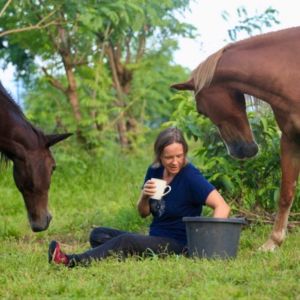
Jay: What is the Richmond Vale Academy all about?
Stina The Richmond Vale Academy is a registered Vincentian nonprofit. We have run initially a lot of volunteer programs. People come to train; they learn to work in a team. They learn about community work, community building, protecting the environment and reducing poverty. So, there were quite a number of programs until about 2010, when I’m going to say I met Thomas.
Hurricane Thomas! So, we met this hurricane and it made us ask a whole lot of questions. Will this be more frequent? What are the consequences for Small Island States?
Thomas gave us a very big shock. I’m not a farmer…well I am now. When I came to St. Vincent, we learned how to farm. We did conventional farming with chemicals. We had lots of bananas and in one blow, all the bananas were down. So it made us question a lot. The bananas were not wind resilient. They were not rain resilient. The farming was really unsustainable. From that experience, along with a volunteer program at the Academy, we initiated a program we have called the ‘St. Vincent Climate Compliance Conference’. We planned and mapped it out in 2011. And from 2012, until today we have run this ongoing, standing, action conference.
Jay: Where does regenerative agriculture fit into the picture?
Stina: This has involved a number of tree-planting actions, cleanup actions and changing of farming from unsustainable to sustainable, meaning regenerated farming. Some call it organic, some call it permaculture, but really it’s the farming that protects the atmosphere, the soil, our health and our biodiversity instead of destroying it, which conventional agriculture really does.
At the end of the day, if we can assist people to understand the actions between what we as humans do to mother earth and the reaction back to us, we can assist in making this a better and more resilient place for all of us.
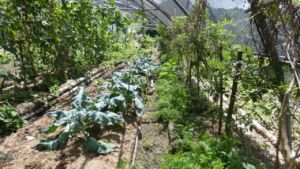
Jay: What type of data is collected by the Richmond Vale Academy?
Stina: We’ve collected quite a lot of data throughout the years. The number of trees planted, the number of garbage bags found on the beaches and in the rivers etc. However, I wished I had collected more data from the Richmond Vale Coastal Conservation project. For example, the location of sea grapes, red mangrove, white mangrove. I have a lot of pictures, but I wished we would have done that before this eruption. Hopefully those trees will stand, but we don’t know.
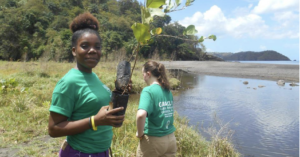
Jay: What is the local/community response to the Richmond Vale Academy and your model?
Stina: I think their response is very curious, very engaging. In the normal school system unfortunately there’s extremely little focus on climate change, sustainability and health. A lot of focus is on the academical skills for the head, and very few skills for the hands and the heart. The Academy works with people from across the island. The response has been really good. Many people have brought new tools back to their homes to make backyard gardens, to plant more trees…So, I think this has sparked a lot of good vibes and movements to protect our nature.
Jay: So here comes a trickier question. What has your experience been like during the ongoing volcanic eruptions?
Stina: Well, this has been very difficult. The thing I have really found admirable about the whole situation is the manner in which the government, the National Emergency Management Organisation, and the scientists from the University of the West Indies have been able to keep us in the loop all the time — almost every day, since the 27th of December — this is really commendable.
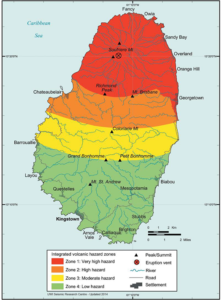
Personally, for the staff at the Academy, we followed the progress of the volcano and then could make evacuation plans. In January, we evacuated the students. We were able to rent a house in Buccament (Green Zone), we purchased masks, personal protection gear and so on. So we were able to prepare and we had the resources to prepare well.
As time went by it looked as if nothing was going to happen. Maybe she [La Soufrière] would go back to sleep again. But she didn’t. The evacuation order was very timely, very precise. So when the evacuation order was called we packed up what we could…closed our doors and whatever we could close and put extra water out for the animals. We also opened the gates to the animals. We also brought some of the animals with us, and then we evacuated.
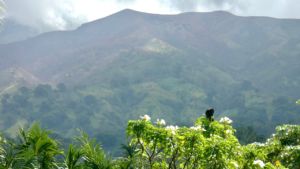
The evacuation process…it’s quite stressful. You are nervous, you evacuate…then comes the first explosive eruption and so the whole emotional part. Of course I think it shakes most people. It shook me very much, but we could move to this safe place where we also had some water stored. There were some days without any water, but thankfully the river is nearby, so we could manage. We were able to focus our efforts to speak to all the people who have been to the Academy…all our contacts, organisations abroad…and start to raise money. The response has been overwhelming. We are very humbled by the response.
Jay: Awesome. The Academy is well known for emergency assistance, what are the plans to help with the restoration and recovery efforts?
Stina: Yes. Some things come naturally and some require a different type of response. For example, we met a farmer with 20 goats and obviously she can’t bring them to the emergency shelter. There have also been calls from community leaders about some elderly persons in our area. So immediately, we responded to persons contacting us about their needs.
I can say that the government is a fantastic fundraiser. We can see that they’ve been able to raise a lot of funds and a lot of help is coming in. Obviously, it takes time. So, there’s a lot of immediate needs, even though the government gets out to all the shelters. The impression I get is that there is a very good system. It doesn’t mean it’s perfect, but it’s a good system.
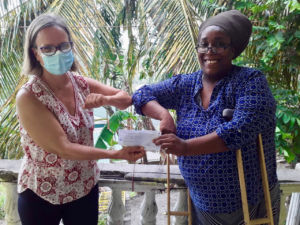
So, thinking ahead. We were working on establishing home gardens; however, the project was paused because of COVID-19 and now we had to move this project from the Red Zone. We want to resume this project, which we moved to the Green zone and will continue after some assessments. We are responding to the needs of farmers. The Academy has worked a lot on food and water security, and we have many farmers who are in a dire need of support.
Many have lost all their crops and several don’t have the chance to feed their animals or the opportunity to go back and see to them. We’ve been assisting as many farmers as we can. And this we do in a corporation with the Vincentian Society for Prevention of Cruelty to Animals.
The conservation efforts, training, teaching and mobilizing people is something we will intensively continue to do no matter where the school is located, because is so crucial for our future. I foresee that we will support regenerative agricultural efforts and be involved in the reconstruction.
The Academy will do all we can to have more backyard gardening because backyard gardening solves many things. You see, it’s a livelihood, it’s a connection with nature. You get your fingers in the soil. It has a healing effect. The whole home garden thing is beyond tomatoes. It is much more. It’s biodiversity, soil enhancement, it’s land degradation protection.
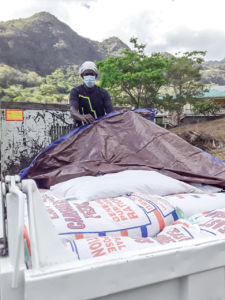
Jay: Do you think the Academy and farm will be able to bounce back after this natural disaster?
Stina: Yeah, that’s a bit hard to answer. What I imagine is that it will take a number of months before it will be declared safe to go back. Our farm will most likely be totally damaged, however, we still have all the knowledge and the experience. We didn’t leave all of that behind, that we brought the knowledge with us. So fortunately, a volcano or flooding or a hurricane can’t take that away from us. We have all the old experiences and we are making new experiences all the time.
What we will need to do when it’s cleared…safe to go back, is to assess the situation and then move from here. Maybe we rent a field. We’ve already started backyard gardening here.
Jay: Restore our earth, what does it mean to you?
Stina: Somehow, humans have drifted away from nature and understanding the ecosystems that sustain us and that we are part of the mother earth ecosystem. And I really think this is very hard for people to reconnect with nature and understand that we need to protect these systems. I do see that millions of people are waking up.
As an organization working with the theme of protecting nature and the people in it, we connect with people who do the same, which is wonderful. I’m in a very fortunate position to see how many people are involved. If you’re not, you may think there’s nothing we can do, but there is a lot we can do. There is a lot happening right now.
Jay: Random question of the day. What’s on your playlist as you go through this volcanic eruption.
Stina: That’s interesting. I love to listen to Aretha Franklin. I love Bob Marley. I love Jimmy Cliff and I have been listening to the Black Pumas (Colors). However, since the evacuation I haven’t listened to much, but I will return to it because I love listening to music.
Related News

prev





